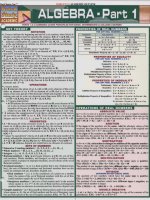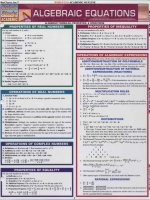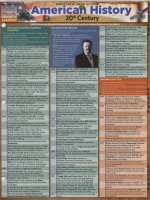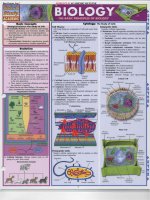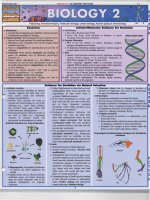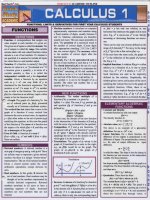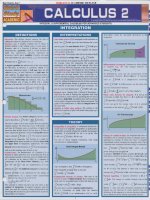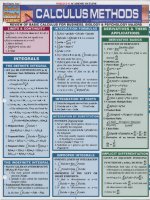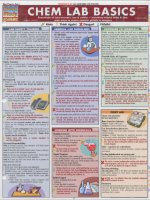- Trang chủ >>
- Khoa Học Tự Nhiên >>
- Vật lý
Quick study academic solar system 600dpi
Bạn đang xem bản rút gọn của tài liệu. Xem và tải ngay bản đầy đủ của tài liệu tại đây (7.82 MB, 4 trang )
: What Is Our
!
:
Our solar system consists of many objects m predictable orbits around the slln These orbits are predlct<1hle
because the gt'avity of the sun keeps the planets, dwarf planets, asteroids, comets, and other ohJects tr<1vl'ilT1g
111 regular paths. Most orbits 111 our solar system are 111 the shape of an ellipse, rather than a perfect clfcle
SIS
.,
0 ar ystem •
.
.
~--~
~-
Solar System Basics
•
ESSENT1AL I ERMS
•
•
•
•
•
•
•
•
•
•
•
dwarf planet - a large, nearly round object orbiting
a star that ha s not cleared the neighborhood of its
orbit
when referring t o orbits, means:
, in t he s hape of a n ova l
ellipse - oval shape
_ _ _ _..
extratenestrial - occurring out side of Ea rth a nd
"",C,",lltlri" -
of stars, gas, and dust
gravity - phys ica l force of na t ure tha t causes two
bodie s t o attra ct each ot her
the distance that light travels in one
5,878,499,814,210 miles)
- the m e a sure of the amount of matter in an
mean distance (of a planet from the sun) - the
average of the distances during one revolution of
the
orbit - pat h of on e object a round a n other, like the
m oon aroun d Earth or Earth a round the s un (see
speed - the average speed at which one
around another
planet - very large, n ear ly round body in orbit
a rou nd a star
- referring to a time before recorded
body
solar system - a group of objects-including
planets, asteroids, and comets-held by the gravity
of a star
u se of device s li ke
•
•
•
•
•
•
•
•
•
•
•
•
•
•
•
•
•
•
•
•
•
•
•
•
•
•
•
•
•
•
•
The International
Astronomical union (IAU)
develops official definitions
for astronomical objects.
According to the IAU, a planet
is a celestial body that is in orbit
around the sun, is massive enough for
its self-gravity to create a nearly round shape, and
has cleared the neighborhood around its orbit.
By thi s definition, our s olar system ha s eight
planets: Men:ury, Venus, Earth, Mars,
Jupiter, Saturn, Uranus, and Neptune. Some
astronomers call these the major planets.
HOW A RE PLANETS CLASSIFIED?
•
•
Planets are usually classified by composition or
size.
TerTeStrial planets have a solid sUrface made
of rock and metal, and have a slow rotation, high
density, and few satellites. Mercury, Venus,
Earth, and Mars are terrestrial planets. They are
also classified as small planets, with diameters
less t han 13,000 kilometers (8,077 miles).
Jovian planets are made of gas and liquid (su ch
as hydrogen and helium), and have a rapid
rotation, low density, and many satellites. Jupiter,
Saturn, Uranus, and Neptune a re }Qyian
planets. They are also classified as giant planets,
with diameters greater than 48,000 kilometers
(29,825 miles).
•
•
For many years, pluto was class ified a s a planet,
but the IAU officially reclassified it as a dwarf
planet in 2006. A dwarf planet shares all the
characteristics of a planet exc:~ that it has
not cleared the n eighborhood around its orbit.
Currently, there are five celesti a l bodies classified
as dwarf planets: Ceres, Pluto, Haumea,
•
•
•
•
•
•
•
•
•
•
•
•
•
•
•
•
•
•
•
WHAT IS A DWARF PLANET?
as new objects are found and more information is
gathered about the objects sci entists a re a lready
aware of.
WHAT IELSE ORBITS THE SUN?
Object s orbit ing the sun that are smaller than
dwarf planets are called solar system bodies.
These inclu de aste1'oids and comets.
Asteroids are rocky fragments left over from the
format ion of our solar system billions of years
ago. Most asteroids are found orbiting the sun
between Mars and Jupiter in a region called the
Asteroid Belt.
Comets are dirty-ice remains from the formation
of our solar system. Most comets come from
t he icy region beyond Neptune's orbit called the
Kuiper Belt. About a dozen new comets are
discovered each year. Some take less than 200
years to orbit t he sun, while others take as long
as 30 million years!
WHAT DOES THE SUN ORBIT?
The sun-in fa ct, our entire solar system---orbit s
the center of the Milky Way galaxy. This galact ic
center is about 2 6,000 light years fro m the sun ,
so the trip around it t a ke s a very long time .
Traveling in
an elliptical
orbit at
about 140
mile s per
second,
the sun
(and thus
our solar
system)
t a kes a bout
22smillion
years to complete one orbit. This orbita l period
is known as a cosmic year.
Solar System in Detail
.
Need to Know:
• third planet from the sun
• only planet known to support life
• oldest fossils of living organisms are 3.9 billion years
old
• only planet with liquid water on the surface
only major planet with a name not derive d
from Greek or Roman mythology (Earth comes from
the Anglo-Saxon word erda, meaning"ground, soil, or
earth "); core can reach temperatures higher than the
surface of the sun; light from the sun takes about e ight
minutes to reach Earth; rotation changes slowly over
time (scientists think that, 900 million years ago, there
were 481 18-hour days in a year!)
• I Fun Facts:
I
• closest planet to the sun
• smallest major planet
• has greatest daily temperature variations of all planets
• has a highly eccentric orbit, causing its distance from
the sun to vary greatly during each revolution
•
•
•
•
•
-r----------------------, .
Fun Facts: named after the Roman god of travel; often I •
•
visible with binoculars, but is always very close to the
sun, and so is only visible at dawn and dusk; humans
I .
have seen less than half of Mercury's surface
I •
•
•
•
•
•
•
•
•
•
•
•
•
• affects seasons, ocean currents, weather, and climate
•
on Earth
•
• composed of 70% hydrogen, 28% helium, and 2%
•
other metals
--------------, ••
I Fun Facts: contains more than 99.8% of the total mass
•
I
of our solar system; one of more than 100 billion stars
•
in the Milky Way galaxy (but the closest star to Earth);
•
about 100 times larger than Earth l
Need to Know:
• center of our solar system
• brightest object in Earth's sky
• star of average size, brightness, and intensity
• provides light and energy needed for life on Earth
•
•
Need to Know:
• second-brightest object in Earth's sky
• Earth's only satellite
• gravitational forces between Earth and t he moon cre
ate high and low ocean tides
• revolution of the moon around Earth, and its location
with respect to the sun, create the phases of the moon
seen in the Earth's sky
•• Ir Fun Facts: only extraterrestrial body to have been
• I visited by humans; only 12 people have walked on th E'
moon; Neil Armstrong was the firs t person to walk on
the moon on July 20, 1969 (his footprint will last for mil
lions of years b e cause the moon has no air); we always
see the same side of the moon because its rotatio n
period is the same as its orbita l period
•
•
•
•
•
• Need to Know:
• second planet from the sun
• has most circular orbit of any planet
• third-brightest object in Earth's sky
• nearly the same size as Earth (95% of Earth's diameter
and 80% of Earth's mass)
r---------------------
Fun Facts: named for Roman goddess of love and
• I
• I
beauty; dense clouds prevent even the most powerful
telescopes from seeing the surface; surface tem
perature is hot enough to melt lead; one Venus day is
longer than a Venus year!
2
Solar System in Detail (continued)
•
Need to know:
Need to know:
• fifth planet from the sun
• largest planet (more than twice as massive as all other
planets combined)
• visible to the unaided eye
• Great Red Spot (a hurricane-like storm) has been ob
served since the 17th century and measures approxi
mately three Earths across
named for Roman god of war; some
I •
times called the Red Planet; several spacecraft have I •
landed on Mars and explored its surface; has our
I •
solar system's largest volcano-Olympus Mons
•
ASTEROID BELT
~
. . .~
•'. ~?~'l
..
. :"
~
. eaiB.~~~e~otd. \ra.·•.~'e;~fprnil
•
•
•
l!eW!te'e\'lto:b~Pfea:s'pf rn"lEIS ""idll
• II
•
•
•
•
• 167 to 418 million miles
• 3-6 Earth years
• first asteroid discovered by Giuseppe Piazzi in I ti01
• Pioneer lOfirst traversed the belt in 1972; Dawn
Mission spacecraft launched in 2007 and is scheduled
to reach Vesta in the Asteroid Belt in 2011
Fun I=acts: named for the Roman king of the gods; has
a faint and thin ring system; has solar system's largest
moon-Ganymede; Galileo Galilei discovered four
of Jupiter's moons in 1610; Jupiter is large enough to
contain approximately 1,300 Earths l
• located between the orbits of Mars and Jupiter
• composed of rocky material remaining from the forma
tion of our solar system
• more than 20 large (diameter greater than 125 miles)
asteroids have been identified, but there are millions of
smaller ones
•
•
•
•
•
• mostly hydrogen
• Johann Gottfried Galle, 1846
• Voyager 2 in 1989 (only visit)
Need to Know:
• eighth planet from the sun
• not visible to the unaided eye
• has four very faint and thin rings
in atmosphere makes the planet appear blue, has a
"fluctuating" giant storm, known as the Great Dark
Spot, with far less intensity than its counterpart on
Jupiter; has the strongest winds in our solar system,
_m.!:a.:ured at over 1,200 mph!
•
Need to know:
• sixth planet from the sun
• least dense of all planets
• has the most prominent and easily visible rings (com
posed of billions of small chunks of ice and rock)
• visible to the unaided eye (but need a telescope to see
_the
rings)
___ _
e r
• ~un ~act8: named for Roman god of agriculture; the
• diameter of Saturn's rings is about 155,000 miles, but
•
•
•
•
•
they are less than a mile thick; pressure is so strong that
a metal spaceship would be crushed like a paper cup in
Saturn's atmosphere
,
.
I •
I •
I •
I •
•
•
Need to know:
• I
• I
•
•
•
•
•
•
•
I .
Need to know:
• pronounced (KY·per)
• extends from Neptune's orbit to about 5 billion miles
from the sun
• often called our solar system's "final frontier"
• contains icy objects and debris, including four known
dwarf planets, and countless comets
~un ~act8:
origin of most comets in solar system; named
for astronomer Gerald Kuiper who theorized its existence
in the 1950s; scientists estimate at least 35,000 KBOs
have diameters greater than 100 kilometers (62 miles)
•
•
•
•
•
•
•
•
•
•
•
•
•
•
•
•
•
•
•
•
•
•
•
•
•
•
•
•
•
•
•
•
Need to know:
I
•
·
·
·
• I ~un ~act8: named for Roman god of the sea; methane
•
•
•
•
named for Roman goddess of grain and
agriculture; contains about 30% of the Asteroid Belt's
total mass; some scientists think Ceres might contain
fresh water
•
I
I
I
I
• 13 known
• does not have a solid surface
•
•
•
•
•
•
total mass of all asteroids equals less than
that of Earth's moon; Vesta, the largest known asteroid,
is visible to the unaided eye; scientists believe asteroids
have hit Earth in the past, causing major changes in the
planet's geology and life
~un ~act8:
•
•
•
•
~un ~act8:
I
• • 163.7 Earth years
•
• • 3·ffi~it~p1lC!m}~4Q\:lFp"'\T~:~I;~tlf&W~:;\';:\\\lt~:
•
•
•
•
•
•
Need to know:
• classified as an asteroid until 2006
• only known dwarf planet in the Asteroid Belt
• not visible to the unaided eye
•
• Pioneer 10 In 1973
•
•
~un ~act8:
• '. ml,11s ",,;res
. .
• • 2.793 billion miles
46 (ou to S
•
• • 16 hours, 7 mInutes (Earth time)
• known since prehistoric times
•
•
•
• fourth planet from the sun
• has some of the most varied terrain of any terrestrial planet
~st-explored planet (after Earth)
, reddish color (most likely from iron oxide in soil)
• seventh planet from the sun
• not visible to the unaided eye
• has 11 known, but faint, rings
~un ~act8: nam; d fo; th""., (jr;;eksky ; od ;;nd f;;ther of
Cronus (Greek name for Saturn); faintly bluish color is
caused by methane gas in atmosphere; extreme tilt
of axis (nearly 98°) causes winter to last for 42 years in
total darkness l
•
•
•
•
•
•
•
•
•
•
•
•
•
•
•
•
3
Need to Know:
•
•
•
•
smaller than Earth's moon
classified as a planet until 2006
not visible to the unaided eye
orbit is highly eccentric, causing Pluto to sometimes be
closer to the sun than Neptune is
• brightest known object in the Kuiper Belt
~un ~act8:
named for Roman god of the underworld; is
39 times farther from the sun than Earth is; light from the
sun takes about five and a half hours to reach Pluto I
-
pronounced how-MAY-ah QL ha-oo-MAY-ah
classified as a dwarf planet in 2008
has an unusual football shape
not visible to the unaided eye
•
•
•
•
•
Fun Facts: named for Hawaiian goddess of childbirth
• r
- pronounced MAH-kay-MAH-kay
- classified as a dwarf planet in 2008
- is second-brightest object in the Kuiper Belt (after
Pluto)
- not visible to the unaided eye
and the personification of stone; has fastest rotation
• Fun Facts: named for the god of Rapa Nui (Easter
speed of any dwarf planet or planet
• I
Island), South Pacific creator of humanity and god of
_____ ~ • I fertility (Rapa Nui was discovered just before Easter);
• I appears to have a faintly red color
----~
•
~
Z
o
• - classified as a dwarf planet in 2006
• - is largest known object in the Kuiper Belt and largest
known dwarf planet
• - not visible to the unaided eye
• - is most distant object ever seen in orbit around the sun
•
••
•
•
•
Fun Facts: named after the Greek goddess of discord
and strife; its discovery (especially the fact that it is
larger than Pluto) caused the IAU to demote Pluto to
dwarf planet status
More Solar System "acts
ASTRONOMICAL UNITS
Most scientists use astronomical units (AU) to measure and describe distances
in our soLar system. An AU is defined by the mean distance of Earth from the
W sun (about 93 million miles). AUs make comparing distances from the sun much
~
• Need to know:
easier. For exampLe, Pluto has a mean distance from the sun of 39-44 AU. This
means it is about 40 times farther from the sun than Earth is.
~
• THE EARTH/SUN RELATIONSHIP
•
sun is the most important factor for life on Earth. The sun not only provides
• The
• nearly all the Light and energy needed for survival, it also determines night and
• day and the change of seasons on Earth.
•
Day & Night
Seasons
•
Spinning on its axis at about 1,000 miles per hour,
Earth's seasons are
• Earth takes about 24 hours to complete one rotation. caused by the way
•
daily rotation from west to east causes the
Earth tilts on its axis
• This
distinction between day and night, and has been
as it orbits the sun.
•
(Earth t ilts at 23 .45'
as the basis for measuring time for thousands
• ofused
from its elliptical plane.)
years. [NOTE: The sun rises in the east and sets
• in the
west precisely because the Earth rotates from
Since the axis is tilted,
•
west to east. Otherwise, if the Earth rotated from
east to west, the sun's rising and setting would be
west and east, respectively- the exact opposite of
what actually happens.J
•• •• • • • • • • • • • • • •••••••••••••••• ••
•
COMPARING PLANETS
The chart beLow gives ratios that compare the mass, diameter, and density of
each pLanet to those of Earth. For exampLe, the ratio for the diameter of Mars is 0.53.
This means that the diameter of Mars is about haLf (0.5) the size of Earth's diameter.
....
'.
0055
ow...t... 1 0.38
o-a, I
098
0.12
I
I
0.95
095
011
1
I
I
1
1
I
0.53
1
071
I
3178 I 952
14.5
I
I
9.45
4.01
0.13
023
1121
024
•
•
•
•
•
171
I
1
•
•
d ifferent parts of Earth
are oriented toward the
sun at different times of
the year.
3.88
•
0.29
•
• • • • • • • • • • • • • • • • • •• • • • • • • • • • • • • • •
GRAVITY & WEIGHT
Your weight is a measure of the pull of gravity between you and the pLanet
you are standing on. PLanets have different masses, so they also have different
gravitational pulls . This means that if you could stand on the surface of every
planet, your weight would be different on each one! The chart below shows how
much a 100-pound person would weigh on the surface of each planet.
.....
'
M
WeIght
(in pound.)
'.
,
038
091
1
0.38
254
093
08
1.2
38
91
100
38
254
93
80
120
•
•
•
•
•
•
•
•
•
•
•
•
•
4
4
